前言:
Spring Security和Shiro的比较
1.相同点
①认证功能
②授权功能
③加密功能
④会话管理
⑤缓存支持
⑥rememberMe功能
… …
2.不同点
①Spring Security是一个重量级的安全管理框架;Shiro则是一个轻量级的安全管理框架
②Spring Security 基于Spring开发,项目若使用Spring作为基础,配合Spring Security 做权限更便捷,而Shiro需要和Spring 进行整合开发;
③Spring Security 功能比Shiro更加丰富些,例如安全维护方面;
④Spring Security 社区资源相对于Shiro更加丰富;
⑤Shiro 的配置和使用比较简单,Spring Security 上手复杂些;
⑥Shiro 依赖性低,不需要任何框架和容器,可以独立运行, Spring Security依赖Spring容器;
⑦Shiro 不仅仅可以使用在web中,它可以工作在任何应用环境中。在集群会话时Shiro最重要的一个好处或许就是它的会话是独立于容器的;
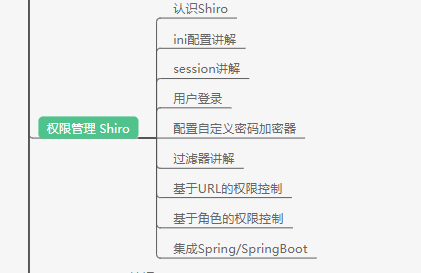
1 、Shiro简介
1.1、什么是Shiro?
- [ ]Apache Shiro 是一个Java 的安全(权限)框架。
- Shiro 可以非常容易的开发出足够好的应用,其不仅可以用在JavaSE环境,也可以用在JavaEE环境。
- Shiro可以完成,认证,授权,加密,会话管理,Web集成,缓存等。
- 下载地址:http://shiro.apache.org/
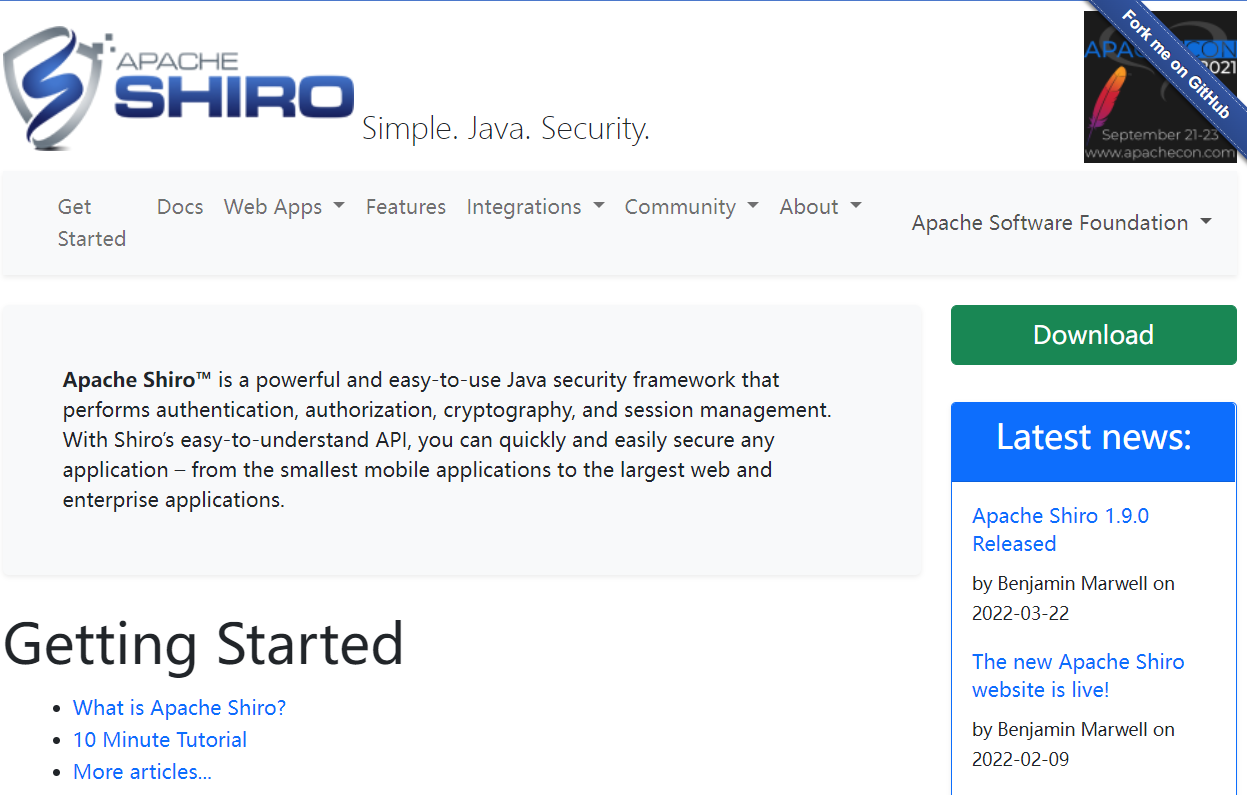
1.2、有哪些功能?
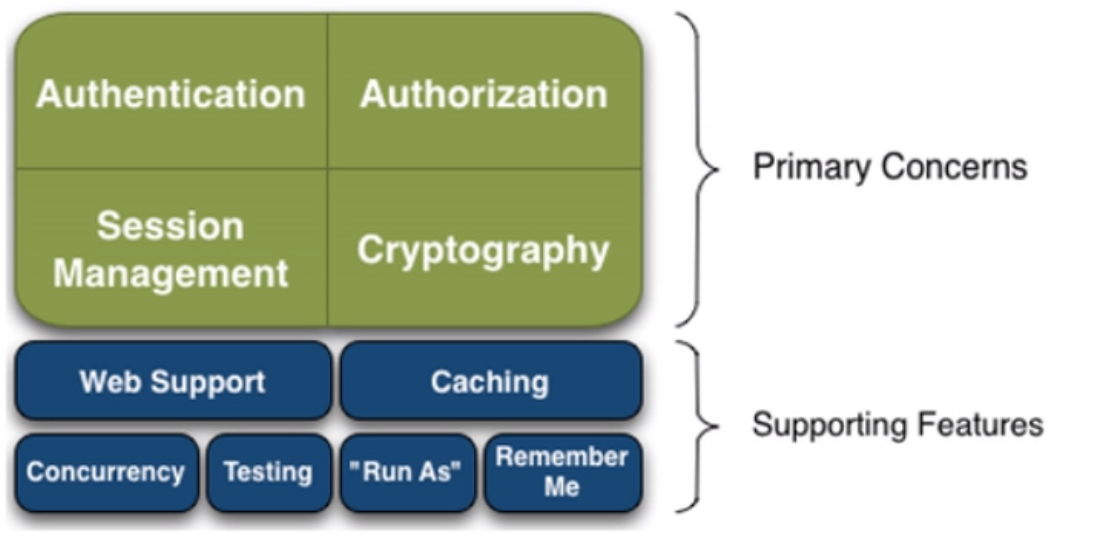
- Authentication:身份认证、登录,验证用户是不是拥有相应的身份;
- Authorization:授权,即权限验证,验证某个已认证的用户是否拥有某个权限,即判断用户能否 进行什么操作,如:验证某个用户是否拥有某个角色,或者细粒度的验证某个用户对某个资源是否 具有某个权限!
- Session Manager:会话管理,即用户登录后就是第一次会话,在没有退出之前,它的所有信息都 在会话中;会话可以是普通的JavaSE环境,也可以是Web环境;
- Cryptography:加密,保护数据的安全性,如密码加密存储到数据库中,而不是明文存储;
- Web Support:Web支持,可以非常容易的集成到Web环境;
- Caching:缓存,比如用户登录后,其用户信息,拥有的角色、权限不必每次去查,这样可以提高效率
- Concurrency:Shiro支持多线程应用的并发验证,即,如在一个线程中开启另一个线程,能把权限 自动的传播过去
- Testing:提供测试支持;
- Run As:允许一个用户假装为另一个用户(如果他们允许)的身份进行访问;
- Remember Me:记住我,这个是非常常见的功能,即一次登录后,下次再来的话不用登录了
1.3、Shiro架构(外部)
从外部来看Shiro,即从应用程序角度来观察如何使用shiro完成工作:
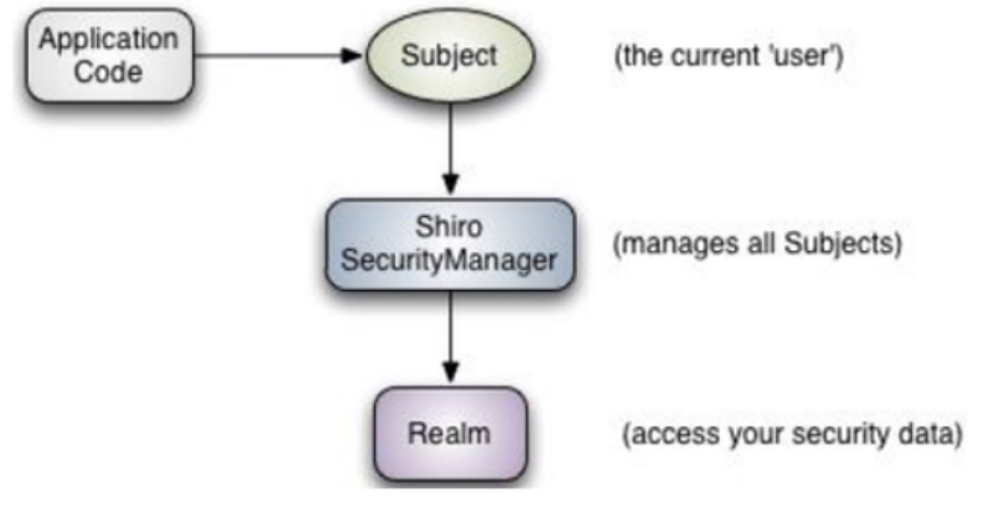
shiro的主要工作流程:
- subject: 应用代码直接交互的对象是Subject,也就是说Shiro的对外API核心就是Subject, Subject代表了当前的用户,这个用户不一定是一个具体的人,与当前应用交互的任何东西都是 Subject,如网络爬虫,机器人等,与Subject的所有交互都会委托给SecurityManager;Subject其 实是一个门面,SecurityManageer 才是实际的执行者
- SecurityManager:安全管理器,即所有与安全有关的操作都会与SercurityManager交互,并且它 管理着所有的Subject,可以看出它是Shiro的核心,它负责与Shiro的其他组件进行交互,它相当于 SpringMVC的DispatcherServlet的角色
- Realm:Shiro从Realm获取安全数据(如用户,角色,权限),就是说SecurityManager 要验证 用户身份,那么它需要从Realm 获取相应的用户进行比较,来确定用户的身份是否合法;也需要从 Realm得到用户相应的角色、权限,进行验证用户的操作是否能够进行,可以把Realm看成 DataSource;
1.4、Shiro架构(内部)
[外链图片转存失败,源站可能有防盗链机制,建议将图片保存下来直接上传(img-Qvhi3eHW-1649061537719)(https://cdn.jsdelivr.net/gh/ladidol/figurebed@main/img/image-20220403183757756.png)]
- Subject:任何可以与应用交互的 ‘用户’;
- Security Manager:相当于SpringMVC中的DispatcherServlet;是Shiro的心脏,所有具体的交互 都通过Security Manager进行控制,它管理者所有的Subject,且负责进行认证,授权,会话,及 缓存的管理。
- Authenticator(认证员):负责Subject认证,**是一个扩展点,**可以自定义实现;可以使用认证策略 (Authentication Strategy),即什么情况下算用户认证通过了;
- Authorizer(授权者):授权器,即访问控制器,用来决定主体是否有权限进行相应的操作;即控制着用户能 访问应用中的那些功能;
- Realm:可以有一个或者多个的realm,可以认为是安全实体数据源,即用于获取安全实体的,可以用JDBC实现,也可以是内存实现等等,由用户提供;所以一般在应用中都需要实现自己的realm
- SessionManager:管理Session生命周期的组件,而Shiro并不仅仅可以用在Web环境,也可以用 在普通的JavaSE环境中
- CacheManager:缓存控制器,来管理如用户,角色,权限等缓存的;因为这些数据基本上很少改 变,放到缓存中后可以提高访问的性能;
- Cryptography:密码模块,Shiro 提高了一些常见的加密组件用于密码加密,解密等
2 、HelloWorld
2.1、快速实践
查看官网文档:http://shiro.apache.org/tutorial.html
官方的quickstart:https://github.com/apache/shiro/tree/master/samples/quickstart/
-
创建一个maven父工程,用于学习Shiro,删掉不必要的东西
-
创建一个普通的Maven子工程:shiro-01-helloworld
-
根据官方文档,我们来导入Shiro的依赖
pom.xml文件
<?xml version="1.0" encoding="UTF-8"?>
<project xmlns="http://maven.apache.org/POM/4.0.0"
xmlns:xsi="http://www.w3.org/2001/XMLSchema-instance"
xsi:schemaLocation="http://maven.apache.org/POM/4.0.0 http://maven.apache.org/xsd/maven-4.0.0.xsd">
<modelVersion>4.0.0</modelVersion>
<groupId>org.example</groupId>
<artifactId>shirofeng</artifactId>
<packaging>pom</packaging>
<version>1.0-SNAPSHOT</version>
<modules>
<module>shiro-01-helloworld</module>
</modules>
<properties>
<maven.compiler.source>8</maven.compiler.source>
<maven.compiler.target>8</maven.compiler.target>
</properties>
<dependencies>
<dependency>
<groupId>org.apache.shiro</groupId>
<artifactId>shiro-core</artifactId>
<version>1.4.1</version>
</dependency>
<dependency>
<groupId>org.slf4j</groupId>
<artifactId>slf4j-simple</artifactId>
<version>1.7.25</version>
<scope>compile</scope>
</dependency>
<dependency>
<groupId>org.slf4j</groupId>
<artifactId>jcl-over-slf4j</artifactId>
<version>1.7.21</version>
<scope>test</scope>
</dependency>
<dependency>
<groupId>commons-logging</groupId>
<artifactId>commons-logging</artifactId>
<version>1.2</version>
</dependency>
</dependencies>
</project>
- 编写Shiro配置
resources目录下:
log4j.properties配置文件
log4j.rootLogger=INFO, stdout
log4j.appender.stdout=org.apache.log4j.ConsoleAppender
log4j.appender.stdout.layout=org.apache.log4j.PatternLayout
log4j.appender.stdout.layout.ConversionPattern=%d %p [%c] - %m %n
# General Apache libraries
log4j.logger.org.apache=WARN
# Spring
log4j.logger.org.springframework=WARN
# Default Shiro logging
log4j.logger.org.apache.shiro=INFO
# Disable verbose logging
log4j.logger.org.apache.shiro.util.ThreadContext=WARN
log4j.logger.org.apache.shiro.cache.ehcache.EhCache=WARN
shiro.ini(如果是用的idea的话,可能需要安装ini配置文件插件,注意格式不要写错啦,key-value键值对)
[users]
# user 'root' with password 'secret' and the 'admin' role
root = secret, admin
# user 'guest' with the password 'guest' and the 'guest' role
guest = guest, guest
# user 'presidentskroob' with password '12345' ("That's the same combination on
# my luggage!!!" ;)), and role 'president'
presidentskroob = 12345, president
# user 'darkhelmet' with password 'ludicrousspeed' and roles 'darklord' and 'schwartz'
darkhelmet = ludicrousspeed, darklord, schwartz
# user 'lonestarr' with password 'vespa' and roles 'goodguy' and 'schwartz'
lonestarr = vespa, goodguy, schwartz
# -----------------------------------------------------------------------------
# Roles with assigned permissions
#
# Each line conforms to the format defined in the
# org.apache.shiro.realm.text.TextConfigurationRealm#setRoleDefinitions JavaDoc
# -----------------------------------------------------------------------------
[roles]
# 'admin' role has all permissions, indicated by the wildcard '*'
admin = *
# The 'schwartz' role can do anything (*) with any lightsaber:
schwartz = lightsaber:*
# The 'goodguy' role is allowed to 'drive' (action) the winnebago (type) with
# license plate 'eagle5' (instance specific id)
goodguy = winnebago:drive:eagle5
- 编写我们的QuickStrat(主要步骤有中文备注提示)
import org.apache.shiro.SecurityUtils;
import org.apache.shiro.authc.*;
import org.apache.shiro.config.IniSecurityManagerFactory;
import org.apache.shiro.mgt.SecurityManager;
import org.apache.shiro.session.Session;
import org.apache.shiro.subject.Subject;
import org.apache.shiro.util.Factory;
import org.slf4j.Logger;
import org.slf4j.LoggerFactory;
/**
* Simple Quickstart application showing how to use Shiro's API.
*/
public class Quickstart {
private static final transient Logger log =
LoggerFactory.getLogger(Quickstart.class);
public static void main(String[] args) {
// The easiest way to create a Shiro SecurityManager withconfigured
// realms, users, roles and permissions is to use the simpleINI config.
// We'll do that by using a factory that can ingest a .inifile and
// return a SecurityManager instance:
// Use the shiro.ini file at the root of the classpath
// (file: and url: prefixes load from files and urlsrespectively):
Factory<SecurityManager> factory = new
IniSecurityManagerFactory("classpath:shiro.ini");
SecurityManager securityManager = factory.getInstance();
// for this simple example quickstart, make theSecurityManager
// accessible as a JVM singleton. Most applications wouldn'tdo this
// and instead rely on their container configuration orweb.xml for
// webapps. That is outside the scope of this simplequickstart, so
// we'll just do the bare minimum so you can continue to get afeel
// for things.
SecurityUtils.setSecurityManager(securityManager);
// Now that a simple Shiro environment is set up, let's seewhat you can do:
// get the currently executing user:
//获取当前用户对象subject
Subject currentUser = SecurityUtils.getSubject();
// Do some stuff with a Session (no need for a web or EJBcontainer!!!)
//通过当前用户拿到session
Session session = currentUser.getSession();
session.setAttribute("someKey", "aValue");
String value = (String) session.getAttribute("someKey");
if (value.equals("aValue")) {
log.info("Retrieved the correct value! [" + value + "]");
}
// let's login the current user so we can check against rolesand permissions:
//判断当前的用户是否被认证,
if (!currentUser.isAuthenticated()) {
//令牌
UsernamePasswordToken token = new
UsernamePasswordToken("lonestarr", "vespa");
token.setRememberMe(true);//设置了记住我
try {
currentUser.login(token);//执行登陆操作
} catch (UnknownAccountException uae) {//没有账号
log.info("There is no user with username of " +
token.getPrincipal());
} catch (IncorrectCredentialsException ice) {//密码错误
log.info("Password for account " +
token.getPrincipal() + " was incorrect!");
} catch (LockedAccountException lae) {//锁定异常
log.info("The account for username " +
token.getPrincipal() + " is locked. " +
"Please contact your administrator to unlock it.");
}
// ... catch more exceptions here (maybe custom onesspecific to your application?
catch (AuthenticationException ae) {
//unexpected condition? error?
}
}
//say who they are:
//print their identifying principal (in this case, ausername):
log.info("User [" + currentUser.getPrincipal() + "] logged in successfully.");
//test a role:
if (currentUser.hasRole("schwartz")) {
log.info("May the Schwartz be with you!");
} else {
log.info("Hello, mere mortal.");
}
//粗粒度
//test a typed permission (not instance-level)
if (currentUser.isPermitted("lightsaber:wield")) {
log.info("You may use a lightsaber ring. Use it wisely.");
} else {
log.info("Sorry, lightsaber rings are for schwartz masters only.");
}
//细粒度
//a (very powerful) Instance Level permission:
if (currentUser.isPermitted("winnebago:drive:eagle5")) {
log.info("You are permitted to 'drive' the winnebago with license plate (id) 'eagle5'. " +
"Here are the keys - have fun!");
} else {
log.info("Sorry, you aren't allowed to drive the 'eagle5' winnebago!");
}
//all done - log out!
//注销
currentUser.logout();
//结束系统
System.exit(0);
}
}
- 运行程序
[main] INFO org.apache.shiro.session.mgt.AbstractValidatingSessionManager - Enabling session validation scheduler...
[main] INFO Quickstart - Retrieved the correct value! [aValue]
[main] INFO Quickstart - User [lonestarr] logged in successfully.
[main] INFO Quickstart - May the Schwartz be with you!
[main] INFO Quickstart - You may use a lightsaber ring. Use it wisely.
[main] INFO Quickstart - You are permitted to 'drive' the winnebago with license plate (id) 'eagle5'. Here are the keys - have fun!
2.2、阅读代码
略
详情请看上面代码的注解
OK,一个简单的Shiro程序体验,我们就在官方的带领下初步认识了!
3 、SpringBoot集成
3.1、准备工作
- 搭建一个SpringBoot项目、选中web模块即可!
pom.xml,新加点东西
<dependency>
<groupId>org.springframework.boot</groupId>
<artifactId>spring-boot-starter-web</artifactId>
</dependency>
<dependency>
<groupId>org.springframework.boot</groupId>
<artifactId>spring-boot-starter-test</artifactId>
<scope>test</scope>
</dependency>
<!--thymeleaf模板-->
<dependency>
<groupId>org.thymeleaf</groupId>
<artifactId>thymeleaf-spring5</artifactId>
</dependency>
<dependency>
<groupId>org.thymeleaf.extras</groupId>
<artifactId>thymeleaf-extras-java8time</artifactId>
</dependency>
-
导入Maven依赖 thymeleaf
-
编写一个页面 index.html templates
<!DOCTYPE html>
<html lang="en"xmlns:th="http://www.thymeleaf.org">
<head>
<meta charset="UTF-8">
<title>Title</title>
</head>
<body>
<h1>shiro首页</h1>
<p th:text="${msg}"></p>
</body>
</html>
- 编写controller进行访问测试
package com.feng.springbootshiro.controller;
import org.springframework.stereotype.Controller;
import org.springframework.ui.Model;
import org.springframework.web.bind.annotation.RequestMapping;
@Controller
public class MyController {
//一般首页不止一个,所以就这样写
@RequestMapping({"/", "/index"})
public String toIndex(Model model) {
model.addAttribute("msg", "hello,Shiro");
return "index";
}
}
- 测试访问首页!
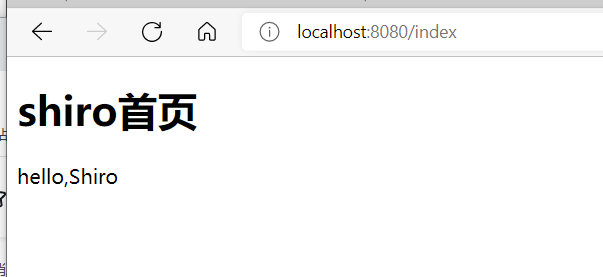
3.2、整合Shiro
-
Subject:用户主体
-
SecurityManager:安全管理器
-
Realm:Shiro 连接数据
步骤:
- 导入shiro依赖
<dependency>
<groupId>org.apache.shiro</groupId>
<artifactId>shiro-spring</artifactId>
<version>1.4.1</version>
</dependency>
- 编写Shiro 配置类 config包
package com.feng.springbootshiro.config;
import org.apache.shiro.spring.web.ShiroFilterFactoryBean;
import org.apache.shiro.web.mgt.DefaultWebSecurityManager;
import org.springframework.beans.factory.annotation.Qualifier;
import org.springframework.context.annotation.Bean;
import org.springframework.context.annotation.Configuration;
import java.util.LinkedHashMap;
import java.util.Map;
//声明为配置类
@Configuration
public class ShiroConfig {
//创建 ShiroFilterFactoryBean( 步骤三
@Bean
public ShiroFilterFactoryBean getShiroFilterFactoryBean(@Qualifier("securityManager") DefaultWebSecurityManager securityManager) {
ShiroFilterFactoryBean shiroFilterFactoryBean = new ShiroFilterFactoryBean();
//设置安全管理器
shiroFilterFactoryBean.setSecurityManager(securityManager);
/*
添加Shiro内置过滤器,常用的有如下过滤器:
anon: 无需认证就可以访问
authc: 必须认证才可以访问
user: 如果使用了记住我功能就可以直接访问
perms: 拥有某个资源权限才可以访问
role: 拥有某个角色权限才可以访问
*/
Map<String, String> filterMap = new LinkedHashMap<>();
filterMap.put("/user/add", "authc");
filterMap.put("/user/update", "authc");
shiroFilterFactoryBean.setFilterChainDefinitionMap(filterMap);
//修改到要跳转的login页面;
shiroFilterFactoryBean.setLoginUrl("/toLogin");
return shiroFilterFactoryBean;
}
//创建 DefaultWebSecurityManager( 步骤二
@Bean(name = "securityManager")
public DefaultWebSecurityManager getDefaultWebSecurityManager(@Qualifier("userRealm") UserRealm userRealm) {
DefaultWebSecurityManager securityManager = new
DefaultWebSecurityManager();
//关联Realm
securityManager.setRealm(userRealm);
return securityManager;
}
//创建 realm 对象( 步骤一
@Bean
public UserRealm userRealm() {
return new UserRealm();
}
}
- 我们倒着来,先想办法创建一个 realm 对象
- 我们需要自定义一个 realm 的类,用来编写一些查询的方法,或者认证与授权的逻辑
package com.feng.springbootshiro.config;
import org.apache.shiro.authc.AuthenticationException;
import org.apache.shiro.authc.AuthenticationInfo;
import org.apache.shiro.authc.AuthenticationToken;
import org.apache.shiro.authz.AuthorizationInfo;
import org.apache.shiro.realm.AuthorizingRealm;
import org.apache.shiro.subject.PrincipalCollection;
//自定义Realm
public class UserRealm extends AuthorizingRealm {
@Override
protected AuthorizationInfo doGetAuthorizationInfo(PrincipalCollection principals) {
System.out.println("执行了=>授权逻辑PrincipalCollection");
return null;
}
@Override
protected AuthenticationInfo doGetAuthenticationInfo(AuthenticationToken token) throws AuthenticationException {
System.out.println("执行了=>认证逻辑AuthenticationToken");
return null;
}
}
3.3、页面拦截实现
- 编写两个页面、在templates目录下新建一个 user 目录 新建两个页面
add.html
<!DOCTYPE html>
<html lang="en"xmlns:th="http://www.thymeleaf.org">
<head>
<meta charset="UTF-8">
<title>add</title>
</head>
<body>
<h1>小小的add</h1>
</body>
</html>
update.html
<!DOCTYPE html>
<html lang="en"xmlns:th="http://www.thymeleaf.org">
<head>
<meta charset="UTF-8">
<title>update</title>
</head>
<body>
<h1>小小的update</h1>
</body>
</html>
在template下新建一个首页
nihao.html(这里充当首页的意思)
<!DOCTYPE html>
<html lang="en">
<head>
<meta charset="UTF-8">
<title>登录页面</title>
</head>
<body>
<h1>登录页面</h1>
<hr>
<form action="">
<p>
用户名: <input type="text" name="username">
</p>
<p>
密码: <input type="text" name="password">
</p>
<p>
<input type="submit">
</p>
</form>
</body>
</html>
- 编写跳转到页面的controller
@RequestMapping("/user/add")
public String toAdd(){
return "user/add";
}
@RequestMapping("/user/update")
public String toUpdate(){
return "user/update";
}
@RequestMapping("/toLogin")
public String toLogin(){
return "nihao";
}
- 测试,完全OK!

点击两个连接都会跳转到登录界面
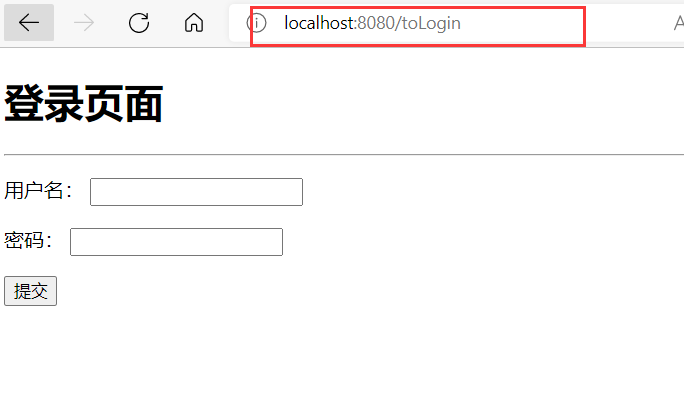
3.4、登录认证操作
结果:
当用户名不存在的时候
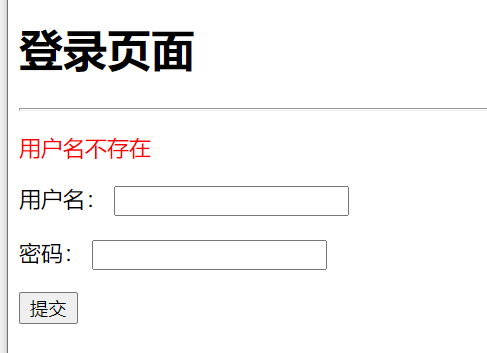
密码错误:
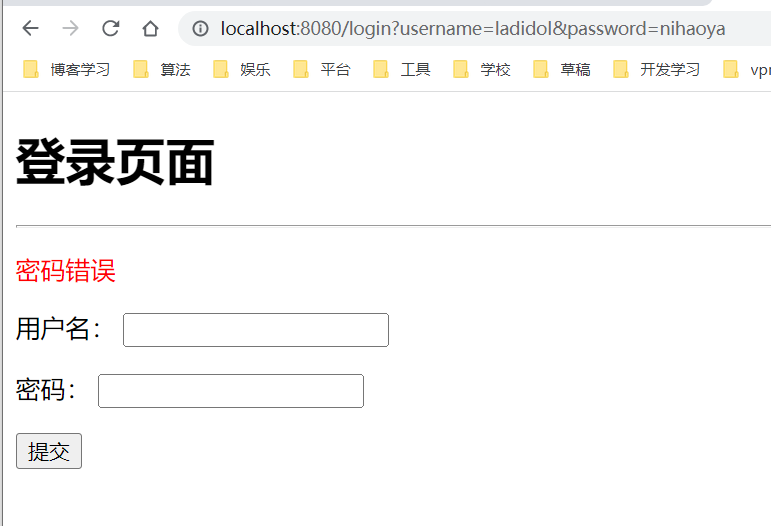
每一次提交账号和密码都会执行认证逻辑

成功就会跳转到首页:
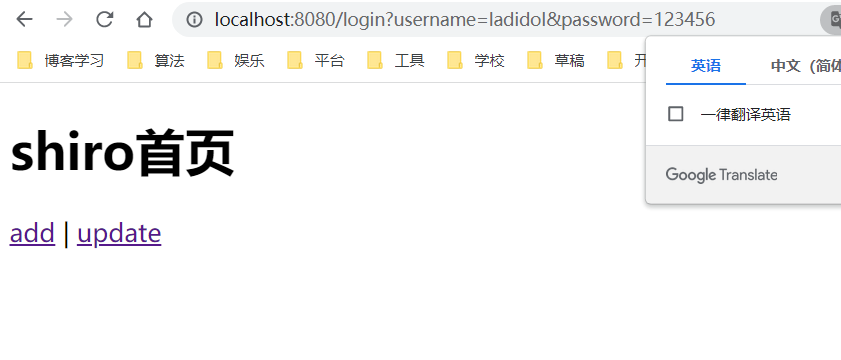
两个链接也都可以访问了
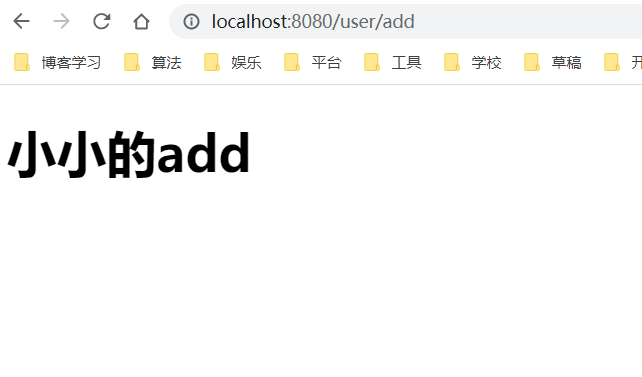
3.5、整合数据库,来执行登录认证操作
- 导入Mybatis的相关依赖:
<!--整合数据库,来查询用户信息-->
<!-- 引入 myBatis,这是 MyBatis官方提供的适配 Spring Boot 的,而不是Spring
Boot自己的-->
<dependency>
<groupId>org.mybatis.spring.boot</groupId>
<artifactId>mybatis-spring-boot-starter</artifactId>
<version>2.1.0</version>
</dependency>
<dependency>
<groupId>mysql</groupId>
<artifactId>mysql-connector-java</artifactId>
<scope>runtime</scope>
</dependency>
<!-- https://mvnrepository.com/artifact/log4j/log4j -->
<dependency>
<groupId>log4j</groupId>
<artifactId>log4j</artifactId>
<version>1.2.17</version>
</dependency>
<!-- https://mvnrepository.com/artifact/com.alibaba/druid -->
<dependency>
<groupId>com.alibaba</groupId>
<artifactId>druid</artifactId>
<version>1.1.12</version>
</dependency>
<dependency>
<groupId>org.projectlombok</groupId>
<artifactId>lombok</artifactId>
<version>1.18.22</version>
</dependency>
- 编写配置文件,的数据库连接配置application.yaml文件
spring:
datasource:
username: root
password: nihao123
#?serverTimezone=UTC解决时区的报错
url: jdbc:mysql://localhost:3306/shiro_feng?serverTimezone=UTC&useUnicode=true&characterEncoding=utf-8
driver-class-name: com.mysql.cj.jdbc.Driver
type: com.alibaba.druid.pool.DruidDataSource
#Spring Boot 默认是不注入这些属性值的,需要自己绑定
#druid 数据源专有配置
initialSize: 5
minIdle: 5
maxActive: 20
maxWait: 60000
timeBetweenEvictionRunsMillis: 60000
minEvictableIdleTimeMillis: 300000
validationQuery: SELECT 1 FROM DUAL
testWhileIdle: true
testOnBorrow: false
testOnReturn: false
poolPreparedStatements: true
#配置监控统计拦截的filters,stat:监控统计、log4j:日志记录、wall:防御sql注入
#如果允许时报错 java.lang.ClassNotFoundException:org.apache.log4j.Priority
#则导入 log4j 依赖即可,Maven 地址:https://mvnrepository.com/artifact/log4j/log4j
filters: stat,wall,log4j
maxPoolPreparedStatementPerConnectionSize: 20
useGlobalDataSourceStat: true
connectionProperties: druid.stat.mergeSql=true;druid.stat.slowSqlMillis=500
mybatis:
#似乎没起作用
type-aliases-package: com.feng.springshiro.pojo
mapper-locations: classpath:mapper/*.xml
- 编写试题类:又引入lombok
package com.feng.springbootshiro.pojo;
import lombok.AllArgsConstructor;
import lombok.Data;
import lombok.NoArgsConstructor;
@Data
@AllArgsConstructor
@NoArgsConstructor
public class User {
private int id;
private String name;
private String pwd;
}
- 编写mybatis那几层:
package com.feng.springbootshiro.mapper;
import com.feng.springbootshiro.pojo.User;
import org.apache.ibatis.annotations.Mapper;
import org.apache.ibatis.annotations.Param;
import org.springframework.stereotype.Repository;
@Repository
@Mapper
public interface UserMapper {
public User queryUserByName(@Param("name") String name);
}
package com.feng.springbootshiro.service;
import com.feng.springbootshiro.pojo.User;
public interface UserService {
public User queryUserByName(String name);
}
package com.feng.springbootshiro.service.impl;
import com.feng.springbootshiro.mapper.UserMapper;
import com.feng.springbootshiro.pojo.User;
import com.feng.springbootshiro.service.UserService;
import org.springframework.beans.factory.annotation.Autowired;
import org.springframework.stereotype.Service;
@Service
public class UserServiceImpl implements UserService {
@Autowired
UserMapper userMapper;
@Override
public User queryUserByName(String name) {
return userMapper.queryUserByName(name);
}
}
UserMapper.xml文件
<?xml version="1.0" encoding="UTF-8" ?>
<!DOCTYPE mapper
PUBLIC "-//mybatis.org//DTD Mapper 3.0//EN"
"http://mybatis.org/dtd/mybatis-3-mapper.dtd">
<mapper namespace="com.feng.springbootshiro.mapper.UserMapper">
<select id="queryUserByName" parameterType="String" resultType="com.feng.springbootshiro.pojo.User">
select * from user where name = #{name}
</select>
</mapper>
- 可以先测试一下数据库整合是否成功:
package com.feng.springbootshiro;
import com.feng.springbootshiro.pojo.User;
import com.feng.springbootshiro.service.impl.UserServiceImpl;
import org.junit.jupiter.api.Test;
import org.springframework.beans.factory.annotation.Autowired;
import org.springframework.boot.test.context.SpringBootTest;
@SpringBootTest
public class Shiro02SpringbootApplicationTests {
@Autowired
UserServiceImpl userService;
@Test
void contextLoads() {
User user = userService.queryUserByName("ladidol");
System.out.println(user);
}
}
如果成功的话就,开始进行realm中的认证了
- 改造UserRealm,连接到数据库进行真实的操作!
package com.feng.springbootshiro.config;
import com.feng.springbootshiro.pojo.User;
import com.feng.springbootshiro.service.UserService;
import org.apache.shiro.authc.*;
import org.apache.shiro.authz.AuthorizationInfo;
import org.apache.shiro.realm.AuthorizingRealm;
import org.apache.shiro.subject.PrincipalCollection;
import org.springframework.beans.factory.annotation.Autowired;
//自定义Realm
public class UserRealm extends AuthorizingRealm {
@Autowired
UserService userService;
@Override
protected AuthorizationInfo doGetAuthorizationInfo(PrincipalCollection principals) {
System.out.println("执行了=>授权逻辑PrincipalCollection");
return null;
}
//执行认证逻辑
@Override
protected AuthenticationInfo doGetAuthenticationInfo(AuthenticationToken token) throws AuthenticationException {
System.out.println("执行了=>认证逻辑AuthenticationToken");
;
//1.判断用户名
UsernamePasswordToken userToken = (UsernamePasswordToken)token;
//真实连接数据库
User user = userService.queryUserByName(userToken.getUsername());
if (user==null){
//数据库中没有找到
//用户名不存在
return null; //shiro底层就会抛出 UnknownAccountException
}
//2. 验证密码,我们可以使用一个AuthenticationInfo实现类 SimpleAuthenticationInfo
// shiro会自动帮我们验证!重点是第二个参数就是要验证的密码!
return new SimpleAuthenticationInfo("", user.getPwd(), "");
}
}
整合后的项目结构:
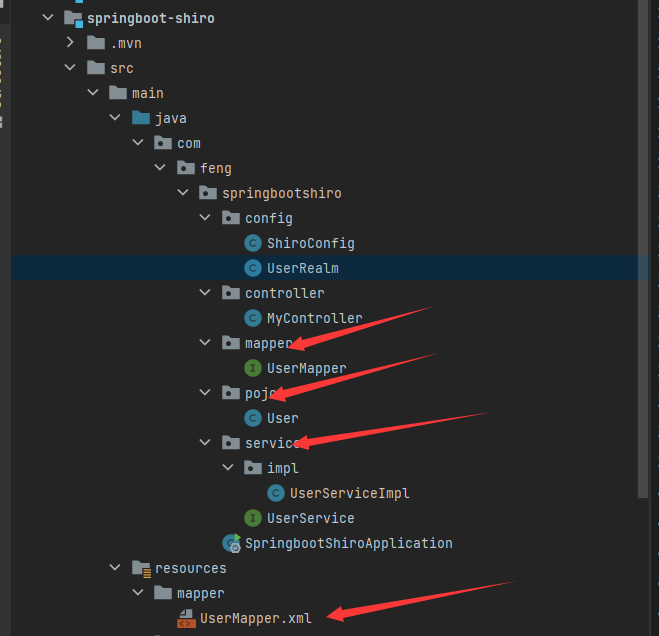
结果:

完全OK,成功查询出来了!
3.6、思考:密码比对原理探究
思考?这个Shiro,是怎么帮我们实现密码自动比对的呢?
我们可以去 realm的父类AuthorizingRealm的父类AuthenticatingRealm中找一个方法 核心: getCredentialsMatcher() 翻译过来:获取证书匹配器 我们去看这个接口 CredentialsMatcher 有很多的实现类,MD5盐值加密

我们的密码一般都不能使用明文保存?需要加密处理;思路分析
- 如何把一个字符串加密为MD5
- 替换当前的Realm 的
CredentialsMatcher属性,直接使用Md5CredentialsMatcher对象, 并设置加密算法
3.7、用户授权操作顺便整合了一下Thymeleaf
- 还要添加一下依赖:
<!--https://mvnrepository.com/artifact/com.github.theborakompanioni/thymeleaf-extras-shiro -->
<dependency>
<groupId>com.github.theborakompanioni</groupId>
<artifactId>thymeleaf-extras-shiro</artifactId>
<version>2.0.0</version>
</dependency>
- .配置一个shiro的Dialect ,在shiro的配置中增加一个Bean
//配置ShiroDialect:方言,用于 thymeleaf 和 shiro 标签配合使用
//这个为了登录者只展示相应链接,这个是前后端不分离的时候
@Bean
public ShiroDialect getShiroDialect(){
return new ShiroDialect();
}
- 修改index中的前端配置
<!DOCTYPE html>
<html lang="en" xmlns:th="http://www.thymeleaf.org" xmlns:shiro="http://www.w3.org/1999/xhtml">
<head>
<meta charset="UTF-8">
<title>Title</title>
</head>
<body>
<h1>shiro首页</h1>
<p th:text="${msg}"></p>
<!--这里主要判断是不是需要展示登录按钮-->
<p th:if="${session.loginUser==null}">
<a th:href="@{/toLogin}">登录</a>
</p>
<!--看权限是否够-->
<div shiro:hasPermission="user:add">
<a th:href="@{/user/add}">add</a>
</div>
<div shiro:hasPermission="user:update">
<a th:href="@{/user/update}">update</a>
</div>
</body>
</html>
- 在shiroconfig中修改请求访问权限:
// filterMap.put("/user/add", "authc");
// filterMap.put("/user/update", "authc");
//授权过滤器
filterMap.put("/user/add","perms[user:add]");
filterMap.put("/user/update","perms[user:update]");
- 数据库表中的修改:

- 实体类的修改:
package com.feng.springbootshiro.pojo;
import lombok.AllArgsConstructor;
import lombok.Data;
import lombok.NoArgsConstructor;
@Data
@AllArgsConstructor
@NoArgsConstructor
public class User {
private int id;
private String name;
private String pwd;
private String perms;
}
- 在controller中添加一个未授权不能访问的提示页面
@RequestMapping("/noauth")
@ResponseBody
public String noAuth(){
return "未经授权不能访问此页面";
}
这时候也要在config中的然后再 shiroFilterFactoryBean 中配置一个未授权的请求页面!
shiroFilterFactoryBean.setUnauthorizedUrl("/noauth");
没登录的话,就可以有thymeleaf来, 展示登录按钮

登录小小就可以有add这个权限:

登录ladidol这个用户就有update这个权限了

ladfeng这个用户暂时没弄权限:

用小小直接访问update的话会返回:

3.8、小结:
如果学习了SpringSecurity 和 Shiro 两个安全的框架,其实什么都不用,我们靠拦截器也可以实现这些功能对吧,但是可能需要花费大量的时间和代码, 还有就是Bug多,思考不全,而现在,我们两个框架都会使用了,也给大家对比的进行学习了,当然真 实的工作中,可能代码会更加的复杂,请多加练习,和复习,也可以看一下源码。
4. 后记:
如果想要更深入了解shiro的话,后续我会再把黑马老师的那个项目分析实现一下,那个结合redis的可能更加适合工作的时候使用;
欢迎点赞关注哦!
也欢迎到访我的博客!小小的博客传送门!


























 1562
1562











 被折叠的 条评论
为什么被折叠?
被折叠的 条评论
为什么被折叠?










